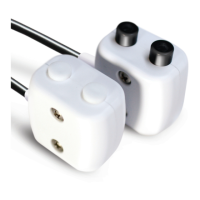3 THEORY SRS Sensors
Figure 7: Another daily variation in NDVI measurements 1 m
above a sub-alpine meadow
3.6 Calculating Percent Reflectance from Paired Up
and Down Looking Sensors
Equation 1 shows that NDVI is the ratio of the difference to the
sum of NIR and red reflectances. Each reflectance is the ratio of up-
welling (down looking sensor) to incident (up looking sensor) radiant
flux in each of the wave bands. Calculating this ratio is only possi-
ble when measurements of downwelling and upwelling radiation are
collected simultaneously under the same ambient conditions. Com-
bining measurements made with sensors located long distances apart
is typically not recommended because atmospheric conditions (e.g.,
cloud cover, aerosols) can be highly variable in space. Reasonable
distances between up looking and down looking sensors will depend
on the typical radiation environment of a given location.
It is also important to arrange paired up looking and down look-
ing sensors to collect data at the same time, which will account for
14

